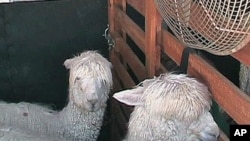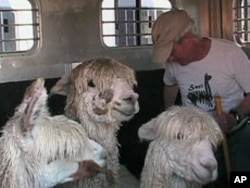Fifteen years ago, Jim Barker's wife came home from an Ohio county fair and told him she'd found their calling.
"She said, 'I just fell in love with an animal and I think we should get a couple of them,'" he recalls. "I said 'What are they called?' And she said, 'Alpaca.' I said, 'Al-what?' I'd never heard of an alpaca."
The Barkers did a little research and learned that alpacas are extremely easy to care for and easy on the environment, too. Four of the animals, which stand about a meter high at the shoulder, can easily be raised on half a hectare. They can eat much rougher vegetation than cattle or sheep and do not challenge fences or tear up pastures like other livestock.
The Barkers bought four animals in 1996, and in 1999, Barker says, "I walked away from my corporate job and started doing alpacas full time."
A small but growing industry
The Barkers are among the more than 4,000 American alpaca breeders who have helped increase the U.S. herd to close to 150,000 animals, worth more than $50 million annually. Each of those highly prized animals is micro-chipped, so they can be tracked and their owners identified.
Unlike in South America, North American alpacas are not raised for meat. Most breeders view their animals as a cross between pet and money-maker.
Bill Pearce, with the Indiana Alpaca Invitational, says the cash comes from the fleece. "It's softer than wool, rated pretty close to cashmere or marina wool. Comes in 22 natural colors."
All those colors are on display at the Indiana Alpaca Invitational, one of the competitions that take place all over the country every spring. Judge Brenda Barboza says the animals are ranked on fleece and confirmation, as well as color.
"[If] you have a male," she explains, "you like [it] to look like a male; very strong, a lot of presence, very proud, the way they walk, well boned, good confirmation and they're bringing in a good fleece on top of that. It's just an all-around animal."
Fluffy or corded
There are two breeds of alpacas, and two types of fleece.
Almost all the American animals are huacayas. They have a fuzzy sheep-like appearance. The other 10 percent are Suris, a breed with long dread-like cords.
The fibers are often blended in textiles, but that doesn't stop owners of the different breeds from being strictly divided.
Rick Stumpf, of Prairie Lake Alpacas in Maryland, for example, is a Suri man. "With their long flowing locks, the Suri is just beautiful to watch with the wind created by the running or natural air movement."
On the other hand, Deb Zeller of Big Hair Alpacas in Ohio, goes for the huacayas. "They're amazing animals," she says, hugging the alpaca she calls Dirty Diana. "They look like big fluffy teddy bears and they make you want to hug them all the time, and they're so peaceful."
While Suris and Huacayas do not compete against each other, both breeds have male and female categories divided into age and color so there are a lot of winners. "At the end of each category - like male brown suris - there is a championship and then there is a reserve champion and a grand champion and color champion," says Barboza, the judge.
The value of a prize-winning alpaca
When the Indiana and other spring invitationals are over, the alpacas will get their annual shearing. Owners of prize-winning animals can command top dollar for their fleece.
Maryland breeder Rick Stumpf says there's a ready market for American-grown alpaca fiber. "Right now, a lot of it is imported from South America, but we are getting more and more alpacas in this country so the alpaca industry is ready. There's excitement to turn more and more of our American alpaca fiber into clothing."
And business is booming. Crafts people are demanding alpaca yarn for blankets and textiles, while designers are clamoring for high end sweater, coat and suit fibers.
To encourage American alpaca farming, the U.S. government offers tax incentives, but Jim Barker says that's only a small reason to start raising alpacas. "I want people to get into the alpaca business because they love the animals as much as we do."
The Barkers now have one more reason to love alpacas. Their animals swept the Suri White Female category at the Indiana Invitational. They'll be going on to the national competition next month.














